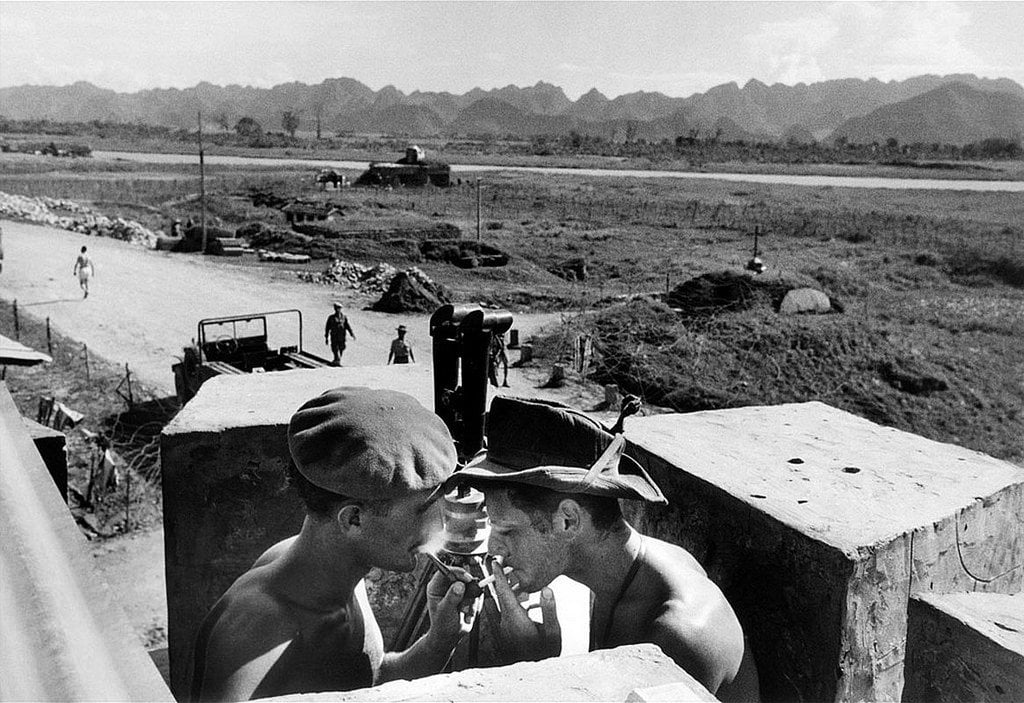Robert Capa once said that ‘if your pictures aren’t good enough, you’re not close enough’, and, indeed, his extraordinary lifelong proximity to war produced some of the most famous photographs of the 20th century. May 25 2017 marks 63 years since he was killed by a landmine explosion in Vietnam. Capa’s untimely death is emblematic of his fearless search for meaningful photographs throughout his career, working as a war correspondent for Life, Time magazine and other esteemed publications. He dared to go further than any other photojournalist of his generation, and it is thanks to his bravery that we now have pictures of such historic moments as the 1944 D-Day landings on Omaha Beach, where no other photographer was present.
Born in 1913 in the Jewish quarter of Budapest, Capa left Hungary at the age of 18 to study in Berlin, a move which would mark the start of a restless life of travel. As anti-Semitism swept through Germany, he fled to Paris, where he met and shared a darkroom with Henri Cartier-Bresson and David Seymour. Almost immediately, his photographs showed a fascination with the individual—his first published photograph was an intense close-up of Leon Trotsky giving a lecture on the Russian Revolution. In 1936 Capa took on his first war assignment documenting the Spanish Civil War. Perhaps his most famous photograph, of a Spanish Loyalist at the moment of death, was taken at this time, and Capa was proclaimed as the world’s best war photographer.
It was also during this early period that war began to influence the young photographer’s personal life. While covering the Battle of Brunete, Capa’s professional partner and wife-to-be, Gerda Taro, was killed. Capa was traumatised and never married after the tragedy. Despite, or perhaps because of this personal tragedy, he continued his work as a war photographer until the end of his life. He, too, was to die prematurely while photographing the Indochina War in 1954. He met his end in conflict, like the very people he captured on film.
Undoubtedly, one of the most striking aspects of Capa’s work is his closeness to his subjects, both physically and emotionally, which allowed him to capture what Cartier-Bresson called ‘the decisive moment’. In doing this, he gave the concept of ‘war’ a new association in the minds of those outside it—that of the human faces behind statistical masses. Capa’s photographs are emotional, and illustrate his belief that ‘in a war, you must hate somebody or love somebody: you must have a position or you cannot stand what goes on.’
At the same time, however, his photography remains that of a restrained observer. Despite his own feelings and those of the American soldiers around him, his photography maintains a level of detachment, allowing for the viewer to form their own opinions on the war. His photographs of dying German prisoners of war are as sensitive and tragic as those of Allied soldiers: they are not ‘the enemy’, but humans who found themselves born in a certain place at a certain time. Likewise, his images of collaborators in liberated France, with their shaven heads, are perhaps not what we would expect. They are simply ordinary people, often women who had had babies by German soldiers. It is up to us, as viewers, to reflect on the way they were treated. As Capa himself said: ‘The truth is the best picture, the best propaganda.’ This is true not only of the suffering of war, but also its victories. The idea of France’s liberation, for example, may fill our imagination with images of immediate, unbridled happiness and freedom, but Capa does not hide the real messiness which accompanies even the most triumphant moments.
The celebrations after the liberation of Paris, for instance, were interrupted by a sniper attack, and he risked his life to document it. Similarly, his photographs from Naples in October 1943 highlight the cost at which the city’s liberation came. His pictures of joy are overshadowed by those of grief and despair at the loss of life, which he believed to be his ‘truest pictures of victory.’ Moreover, Capa manages to convey the sense that world events—even those as great and all encompassing as war—are only ever the consequences of individual actions. By the time they reach newspapers or history textbooks, these actions are forgotten: they are buried in the anonymous narratives whose characters are countries, pacts, and armies. Through his images, Capa preserves some of these moments, and reminds us of the personal level at which the events of war take place. One side’s defeat is not an abstract event which takes place instantly. It is rather a discussion between two generals, or two officers from opposing armies waiting for instructions. As Capa’s photography demonstrates, D-Day wasn’t just a political turning point on a time line. It was the physical wading of thousands of men towards a Nazi-lined shore.
After the Second World War, Capa found himself unemployed, which he described as ‘a war photographer’s most fervent wish.’ He co-founded Magnum Photos in Paris with partners including his long-time friends David Seymour and Henri Cartier-Bresson, and became president of the co-operative in 1952. Yet, two years later, he made his fateful return to the front to cover the Indochina war in Vietnam. War made his career what it was, but also cut it short.



